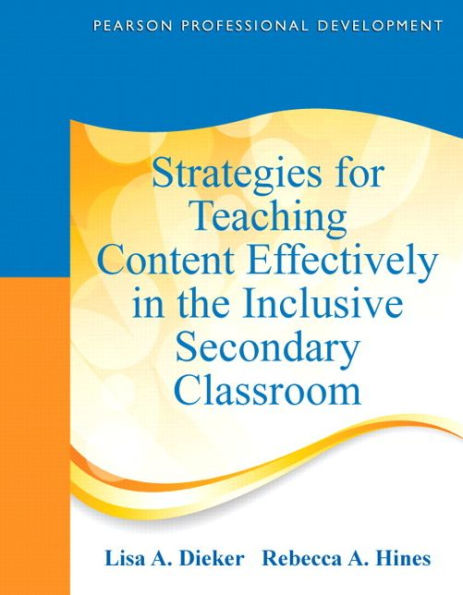Table of Contents
Preface Chapter 1 — Potential Disruption
Rebecca A. Hines and Lisa A. Dieker
The Status of Education: The Game Is Changing
Putting the Pieces Together
Cornerstone of Curriculum and Instruction
Planning Pyramid
Multiple Intelligence
Universal Design for Learning
Instructional Time
Bloom’s Taxonomy
Keeping Pace with Generation M
Standards in Today’s Classrooms
Real-World Skills
Today’s Inclusive Classrooms
Current Status of Special Education
References
Chapter 2 — Status of the Classroom
Rebecca A. Hines and Lisa A. Dieker
The Philosophy of Inclusion
Inclusive Practices: Implications
High-Incidence Disabilities
Learning Disabilities
Emotional Disturbances
Speech or Language Impairment
Low-Incidence Disabilities and 504 Plans
Intellectual Disabilities
Emotional Disturbance and Autism Spectrum Disorders
Individual Education Program
Individual Transition Plan
Meeting the Needs of ALL Learners
Closing Thoughts
5 Realistic Tips
References
Chapter 3 — Adolescence and Positive Climate
Lisa A. Dieker and Rebecca A. Hines
Universal Desires of Adolescents
Overview of Adolescence
Creating a Positive Climate
Universal Principles That Should Be in All Schools
Universal Design for Learning (UDL)
Principle 1: Multiple Means of Representation
Principle 2: Multiple Means for Action and Expression
Physical Action
Expressive Skills and Fluency
Executive Function
Principle 3: Multiple Means for Engagement
Increasing Student Engagement
What Does an Effective Secondary Classroom Look Like Today?
Quality Instruction
Tips for Increasing Instructional Time
Adding New Layers
Promoting a Positive Social Climate
Practice Social Skills Daily
Role Plays
Holding Classroom Forums
Pass a Problem
T-Chart
Books and Movies
Closing Thoughts
5 Realistic Tips
References
Chapter 4 — Rethinking Behavior
Rebecca A. Hines and Lisa A. Dieker
Differing PerspectivesWhat Causes Students to Misbehave?
Old Faithful: Behaviorism
Ecological Model
Psychodynamic Model
Cognitive Model
Conducting a Functional Behavioral AssessmentConsiderations for Students with More Severe Behavior or Emotional/Behavioral Issues
Unconditional Participation
Built-In Success
What Types of Behaviors Should I Expect–And What Can I Do about Them?
Practical Tips for Behavior ManagementClosing Thoughts
5 Realistic Tips
References
Chapter 5 - Co-Teaching and Collaboration
Lisa A. Dieker and Rebecca A. Hines
Inclusion: Civil Rights Issue or Evidence-Based Practice?
The Role of the Teacher in Inclusive Settings
Co-planning
Co-Instructing in the Collaborative Classroom
Lead and Support
Parallel Teaching
Alternative Teaching
Station Teaching
Team Teaching
Keys to Collaboration
Check for Confusion
Don’t Say It All
Stay on Track
Share the Stage
Co-Assessing: Whose Job Is It?
Putting It All Together: Planning, Instructing, and Assessing
Checking It Off — How Is Your Co-Teaching Relationship?
Closing Thoughts
5 Realistic Tips
References
Chapter 6 — Reading in Today’s Classrooms
Rebecca A. Hines and Lisa A. Dieker
What’s the problem?
Learning to Read or Reading to Learn?
To Read or Not to Read?
What is my role in reading instruction?
Bits and Pieces
Reading Barriers
Research-Based Best Practices for All Learners
Using a Reader’s Workshop Approach to Encourage “Reading to Learn”
Closing Thoughts
5 Realistic Tips
References
Chapter 7 — Writing, Listening, and Speaking across the Content Areas
Rebecca A. Hines, Sheri L. Anderson, and Lisa A. Dieker
Emerging Forms of Communication
The Importance of Writing, Listening, and Speaking Skills
Writing
Listening
Speaking
How and Why Should Writing, Listening, and Speaking Be Taught in Today’s Middle and High Schools?
Strategies for Better Writing
Conferencing with Writers
Listening Strategies
Give Me Five
Speaking Strategies
Ideas Related to Writing, Speaking, and Listening
Kamishibai
Authorstream
A Picture Is Worth a Thousand Words
Digital Narratives
Closing Thoughts
5 Realistic Tips
References
Chapter 8 — Creating Mathematically Literate Students
Kimberly Davis, Lisa A. Dieker, and Rebecca A. Hines
Mathematics and Special Education
Co-Teaching
Difficulties for Students with Special Needs in Mathematics
Effective Teaching of Mathematics
Recommendation for inclusion in mathematics
Websites and Ideas for the Classroom
Closing Thoughts
5 Realistic Tips
References
Chapter 9 — Scientific Knowledge
Sara Aronin, Lisa Dieker, and Rebecca Hines
Constructivism in Science
Teaching structure to support science
Safety issues and behavior needs in science
Strategies related to Teaching Science
Websites to visit
General Strategies and Activities to Consider
Connecting Science Concepts to What Students Already Know
An Inquiry-Based Lesson Using Co-Teaching
Students Further Understand the Concept
General Education Provides Pictures and Notes Explaining the Process on the Board
Students Appy the Concept to Life
Closing Thoughts
5 Realistic Tips
References
Chapter 10 — Secondary Social Studies in the Inclusive Classroom
Christopher P. O’Brien
Teaching That Works for Joshua
Scenario: Joshua
Inclusion and Content-Area Instruction in the Accountable Era
What do Adolescents with Learning Problems Struggle with in Social Studies?
What Are Effective Practices in the Social Studies for Engaging Students with Academic Difficulties and Showing Improvements in Learning?
Big Ideas and content Enhancement
More on Content Enhancements
A Note on Graphic Organizers
A Very Simple Content Enhancement: Guided Notes
Strategic Instruction
A Key to Learning Strategies for Social Studies
Reading Support in the Social Studies Classroom
How can Enhancements of Digital Media Help Resolve Old Problems in U.S, Schools?
Accessible Materials
UDL and Multimedia Instruction
Multimedia and Web-Based Resources for Teaching Social Studies
Online Concept Maps
History Resources
Audio Resources for Reading Materials
Closing Thoughts
5 Realistic Tips
References
Chapter 11 — Uncovering What Students Know
Lisa A. Dieker and Rebecca A. Hines
Grading versus Assessment: The ongoing debate
Formative: Daily Assessment
Informal Methods for Assessing Student Understanding
Summative Assessment
High-Stakes Testing
Grading
Schoolwide Considerations for Assessment
Classroomwide considerations: IEP as a living, breathing document
Typical Grading Practices
Combined Grading
Rubric Report Cards
Checklist Grading
Portfolios
Practical Tips for Strong Secondary Schools to Evaluate Their Practices
Closing Thoughts
5 Realistic Tips
References
Chapter 12 — Life Beyond School
Rebecca A. Hines and Lisa A. Dieker
The future of American Education?
Skills Essential for College
Self-Determination
Strategies That Promote Independence
Skills Necessary for Communication
Thinking Differently
Technology and Life Skills
References
Index



